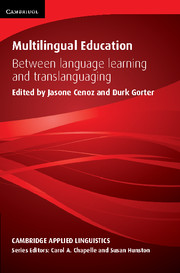Book contents
- Frontmatter
- Contents
- List of contributors
- Series editors’ preface
- Acknowledgements
- 1 Towards a holistic approach in the study of multilingual education
- 2 L1 as a pedagogical resource in building students’ L2 academic literacy: pedagogical innovation in the science classroom in a Hong Kong school
- 3 Linking content, linking students: a cross-linguistic pedagogical intervention
- 4 The role of the native language in the literacy development of Latino students in the United States
- 5 A nexus analysis of code choice during study abroad, and implications for language pedagogy
- 6 Multilingual practices in foreign language study
- 7 Language choices and ideologies in the bilingual classroom
- 8 Communicative repertoires in the community language classroom: resources for negotiating authenticity
- 9 Complementary classrooms for multilingual minority ethnic children as a translanguaging space
- 10 Constructing in-between spaces to ‘do’ bilingualism: a tale of two high schools in one city
- 11 Becoming multilingual and being multilingual: some thoughts
- Index
8 - Communicative repertoires in the community language classroom: resources for negotiating authenticity
Published online by Cambridge University Press: 17 September 2021
- Frontmatter
- Contents
- List of contributors
- Series editors’ preface
- Acknowledgements
- 1 Towards a holistic approach in the study of multilingual education
- 2 L1 as a pedagogical resource in building students’ L2 academic literacy: pedagogical innovation in the science classroom in a Hong Kong school
- 3 Linking content, linking students: a cross-linguistic pedagogical intervention
- 4 The role of the native language in the literacy development of Latino students in the United States
- 5 A nexus analysis of code choice during study abroad, and implications for language pedagogy
- 6 Multilingual practices in foreign language study
- 7 Language choices and ideologies in the bilingual classroom
- 8 Communicative repertoires in the community language classroom: resources for negotiating authenticity
- 9 Complementary classrooms for multilingual minority ethnic children as a translanguaging space
- 10 Constructing in-between spaces to ‘do’ bilingualism: a tale of two high schools in one city
- 11 Becoming multilingual and being multilingual: some thoughts
- Index
Summary
Introduction
Complementary schools (also known as ‘community language schools’, ‘heritage language schools’ or ‘supplementary schools’) are sites in which contrasting social values are intensively negotiated. In the discourses of teachers and students, questions about identity and belonging, and questions of authenticity (Shankar, 2008 ; Blommaert & Varis, 2011 ; see also Li Wei, this volume), routinely surface. These identities and authenticities are far from straightforward. In this chapter we investigate students’ and teachers’ negotiation of ‘authenticity’ in the complementary school classroom. We describe a broad range of identity positions brought into play in the negotiation of authenticity. Even in the tightly controlled and highly normative discursive practices of the language classroom, there is opportunity for a wide range of identity positioning. We examine the processes which make these identity positions available to students as they negotiate shifting allegiances to the social positions they index. Wortham ( 2004 : 166) defines positioning as ‘an event of identification, in which a recognizable category of identity is explicitly or implicitly applied to an individual in an event that takes place across seconds, minutes, or hours’. He describes how habitual and repeated ways of using language may be interpreted as predictable indicators of identity (Wortham, 2008 ).
Like definitions of ‘ethnicity’, authenticity is a ‘muddy’ and ‘positional’ concept (Reyes, 2010 : 399). It can be understood only in context as a constructed, dynamic, shifting and situated practice. In this sense we view the negotiation of authenticity in the heritage language classroom as a creative process in which young people and their teachers consider, resist and enact social change. Blommaert and Varis ( 2011 : 4) suggest that ‘One has to “have” enough emblematic features in order to be ratified as an authentic member of an identity category.’ They describe authenticity as a ‘highly dynamic configuration of features’ which requires ‘constant adjustment, reinvention and amendment’ (p. 4). In this chapter we consider classroom practices in the negotiation of authenticity in relation to a range of identity categories. Discussions of authenticity and repertoire are connected to Hymes's ( 1972 ) concept of ‘appropriateness’ in relation to his notion of communicative competence.
- Type
- Chapter
- Information
- Multilingual EducationBetween Language Learning and Translanguaging, pp. 159 - 176Publisher: Cambridge University PressPrint publication year: 2015
- 2
- Cited by



